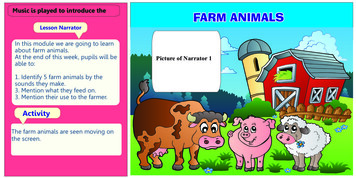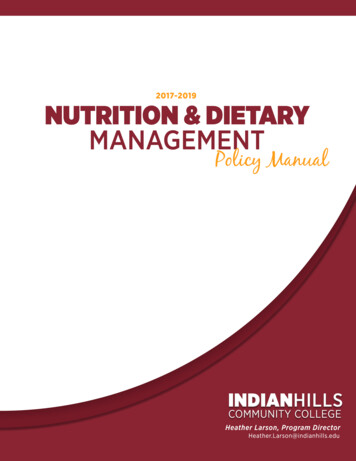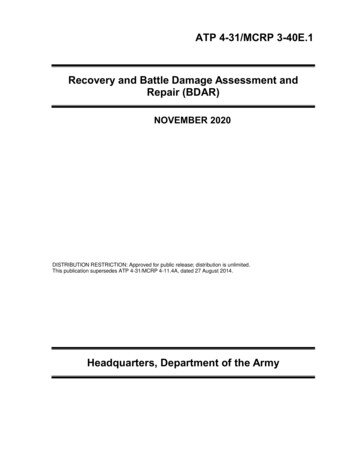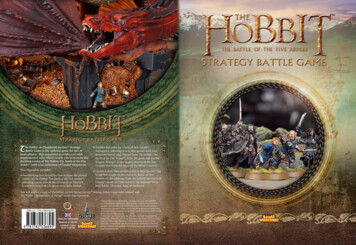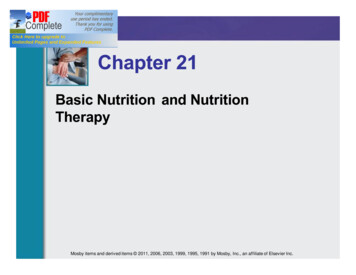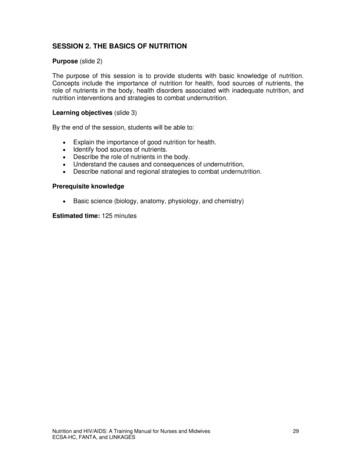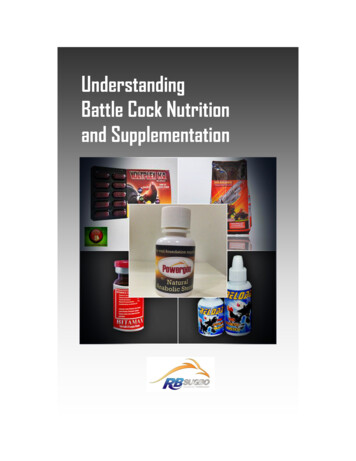
Transcription
UnderstandingBattle Cock Nutritionand Supplementation
UnderstandingBattle Cock Nutritionand SupplementationBy Rey K. BajentingThe role of battle cock nutritionWhat is battle cock nutrition? Gamecock nutrition isalso poultry nutrition but it is not just plain poultry nutrition. It relates to fighting performance. Yes it deals withvitamins, minerals, proteins, fats, supplements and organic substances yet it concerns mostly with the type ofnutrients and fluids that will improve the physical fitnessof the gamecock. It is far different from the other kinds ofpoultry nutrition such as those for layers and broilers.The role of supplementationA supplement is something added to the diet, usually to make up for a nutritional deficiency. Gamecock supplementation, however, is more than that. Akin to humansports ergogenic aids, gamecock supplementation is designed to improve fighting performance.Game fowl conditioning consists of nutrition andexercise. Supplementation serves as the link that will fitnutrition to the requirements of exercise. Supplementationalso acts as the gear that shifts from one stage of conditioning to another.In our pyramid conditioning method, we pointedout that conditioning consists of foundation stage (preconditioning); battle ready stage (conditioning proper);and Peaking and pointing phase. Proper supplementationwould enable the roster to level up from one stage to thenext with ease. (Read about pyramid conditioning in Pilipino, get a copy of Manwal ng MANA sa Pagkundisyonfrom Gamevitz)
Introduction: The outer limitsAvailability of ready feeds and supplements in themarket for gamecocks has made the task of conditioning,nowadays, simple and easy. Of course, not really thateasy because one still has to understand the basics of nutrition, be able to decide intelligently what he wants for hisroosters, and be constantly aware of the situation. Afterwhich, however, all one has to do is to find the right product in the market, instead of formulating and producingthe stuff himself.Traditionally the object of conditioning is to enablethe rooster to perform at its best subject to limitations setby breeding. The principle is that the capabilities of arooster are set in the breeding pen. These capabilities willreach full potential through right rearing and superb conditioning. Accordingly, no amount of rearing and conditioning will enable the rooster to perform beyond these capabilities. This is true. The question is how to get to the limits of these capabilities.The modern objective, however, is to stretch thesecapabilities to the outer limits. Conditioning methods simply consist of good feeding, ample workout and exercises,and efficient supplementation. The task is much uncomplicated because nowadays, already available in the marketare not only excellent feed formulation for gamecocks butalso effective supplementation, but, the goal is always ambitious— getting to the outer limits of the rooster’s capabilities.
I. NutritionNutrition is the study of metabolism. Metabolismconsists of catabolism or how the body breaks food downand anabolism or how the body repairs and creates cellsand tissue. Catabolism and anabolism equals metabolism.Nutritional science also examines how the body responds to food.What is battlecock nutrition? Gamecock nutrition isalso poultry nutrition but it is not just plain poultry nutrition. It relates to fighting performance. Yes it deals withvitamins, minerals, proteins, fats, supplements and organic substances yet it concerns mostly with the type ofnutrient and fluid that will improve the physical fitness ofthe gamecock. It is far different from the other kinds ofpoultry nutrition such as those for layers and broilers.Nonetheless, diets for all types of chickens must beformulated to provide all of the nutrient requirements mayit be for optimum growth or maximum production or fighting performance. These are the six classes of nutrients:Carbohydrates – the major source of energy. Most of thecarbohydrate in poultry diets is provided by grains.Fats – provide energy and essential fatty acids requiredfor some bodily processes.Proteins – required for the synthesis of body tissue andmuscles, physiological molecules such as enzymes andhormones, and for anabolism. Proteins also provide asmall amount of energy.Vitamins – organic chemicals or chemicals containing carbon which help control body processes and are required in small amounts for general well being.Minerals - inorganic chemicals or chemicals not containing carbon. Like vitamins, minerals help control bodyprocesses and aids well being.Water. A very important nutrient, moreover for gamecocks.
In battlecock nutrtion these nutrients are to be provided by two types of feed formulations—the pellets andthe grain mix or grain concentrates.Pelleting was introduced into Europe about 1920and into the U.S. feed industry in the late 1920's (Schoeff,1994). Its popularity has grown steadily until about 80%of all feed. are currently pelleted. Today, the process iswidely used because of both the physical and the nutritional benefits it provides. The physical benefits includeimproved ease of handling, reduced ingredient segregation, less feed wastage, and increased bulk density.Grains on the other hand are seldom use in feedingchickens other than gamecocks, except as scratch or treat.In battle cock nutrition, however, grains are important andplay its own role. Grains are mixed with pellets to providefiber or roughage. Chickens feed solely with pellets tend togrow heavy and sometimes fat. Correct blend betweencertain pellets with certain grains will result in ideal bodyconformation.RB Sugbo Feeding PrinciplesOverviewGamefowl should be lean and fit, much like aboxer. To attain this, we will discuss and consider fourmain nutrition principles: proper eating frequency, propernutrient timing, proper balance of macronutrients andproper total caloric intake. This will enable gamefowl tohave the necessary energy for training.Eating FrequencyWhat is the most common frequency of feeding thegamefowl? Twice a day? Sometimes three including snackat noon. Some even practice the once a day feedingmethod. American James Pope advocated once a dayfeeding. In the past Filipino cockers used to feed theirroosters once a day at 3pm. There was some wisdom tothis. From morning to 3pm when they were fed, the roosters were hungry and more active.Our suggested method, however, is the opposite:we feed many times a day at small portions. We suggest
giving more meals per day to stabilize blood sugar andkeep energy levels high all day long. This eating frequencywill keep glycogen stores (glycogen is energy for the body,formed from the ingestion of carbohydrates) loaded andreloaded. Just like a boxer, this high eating frequency willstart with breakfast and will end with dinner to providerecovery fuel prior to overnight rest. This recovery fuelprior will assist in muscle repair, powering the rooster upfor the next day’s workout. Also; chickens are physiologically suited to this, in the wild chickens are scavengers.As such, they usually consume frequent but small doses ofnutrients. “Isang kahig isang tuka.”Nutrient TimingBefore the early morning workout, give complexcarbohydrate fuel source. (At RB Sugbo we do this by adding 10% grains or cracked corn to the base mix) This willprovide glycogen to facilitate fat burning. Following theworkout, give a recovery fuel source containing mainlycarbohydrates and some protein to reload glycogen stores(add a little whole egg or beef liver to the base mix). Thisrecovery fuel enables roosters to have productive trainingsessions day after day.CarbohydratesCarbohydrates are going to be the mainstay of thenutrition plan. Carbohydrate intake should be 50 to 65percent of total daily consumed calories. Focus on complexcarbohydrates (as opposed to simple sugars) such asgrains, vegetables and fruit. Fruit, will provide great antioxidants. Antioxidants are critical to nutrition plan, asthese will combat free radicals brought about during activities.Protein and FatProtein will make up approximately 18-20 percentof the daily calories. It is the amino acids (building blocksof protein) in the protein sources that assist in muscle repair. Give lean protein sources such as fish, beef, eggwhites and protein supplements. Your third macronutrient,dietary fat, should consist of about 20 percent of daily caloric intake. best dietary fat are from sources such asseeds, fish and flax seed.
Antioxidants and Total CaloriesTo combat free radical damage (free radicals are formedduring times of stress, training, etc.), provide antioxidantsfrom fruits, vegetables and multivitamins. Provide multivitamin, fruit and vegetables with most of the meals andsnacks. In the wild, birds have abundance of foods withhigh anti-oxidant value.Warhawk Optimum is an example of effective conditioning pellets for game fowl. There are alternativeproducts manufactured by other companies.
SupplementationNutritional supplements include vitamins, minerals,herbs, meal supplements, sports nutrition products, natural food supplements, and other related products used toboost the nutritional content of the diet. Nutritional supplements are used for many purposes. They can be addedto the diet to boost overall health and energy; to provideimmune system support and reduce the risks of illness andage-related conditions; to improve physical performance;and to support the healing process during illness and disease. However, most of these products are treated as foodand not regulated as drugs.Like in humans, battle cock supplements may befor general purpose or may be designed to provide specialized support or to serve specific goals. Some of these consist of high-protein products, such as amino acid supplements for anabolism, while other products contain nutrients that support metabolism, energy generation, andoxygen circulation or recovery. Roosters engaging in intense conditioning activities may have increased needs forwater-soluble vitamins, antioxidants, and certain minerals,and electrolytes as well as vitamins, minerals, and performance-supporting herbs. Some supplements may offerparticular benefits or are targeted for specific conditions.These products may consist of whole foods or may be isolated compounds from natural or synthetic sources. Examples include antioxidants, probiotics, digestive enzymes, orother animal products, or chemical extracts such as thehormone DHEA (dehydroepiandrosterone) and coenzymeQ10, an antioxidant. A few supplements are designed notonly for general well-being but to serve many specificgoals. These are rare and valuable.The science of gamecock supplementation, especially in the field of conditioning and pointing has progressed tremendously that it is now doubtful if a relativelyunprepared rooster stands a chance against a superblyconditioned one. Moreover with the advent of countless ofconditioning aids and products in the market today, accessto these so-called wonders is no longer a problem. You
name it you get it. If you hear of a new miracle performance enhancer that reportedly is making champions out ofpatsies, just search the net and you will find where andhow to buy it. (Click here for one such site)Nowadays, companies and enterprising individualsare riding on the popularity of game cock supplements andthey make these wonder drugs available.Gamecock supplementation, however, is not just amatter of buying the many conditioning products nowavailable in the market. It is also a matter of understanding and knowing the products. In this aspect, it would helpif the outfit from which you are buying the stuff has someone with good knowledge of the science of supplementation, because if such is the case, you can readily consultwith them about the products you are going to use. But, itis not enough that this someone is an expert on supplementation, he should also be a certified roosterman whounderstands the ways of the rooster. Cockfighting is an artthat employs science. In order to master the craft, onemust be first and foremost an artist. Science comes next.Thus, to be a complete roosterman one must be capable ofobserving the way of the rooster and of understanding theintricacies of science.For example when one is experimenting with products for gamecocks, most of the objectives are not readilymeasurable. Unlike in broilers where the main concern isthe feed to meat conversion rate, or in layers where eggproduction and egg quality are the parameters, in gamecocks fighting ability, speed, power, and general well beingcan’t be measured tangibly. Therefore, evaluationt is notas straightforward. Judging a cock’s fighting ability is subjective rather than objective. It is something that only experts are qualified to determine.Supplementation by objectives/specific goals:Supplements may be classified many ways. Oneclassification is by form, whether in capsule, pill, suspension, liquid, or powder. Another is by route of administration, whether oral or injectable or even transdermal.
More importantly, supplements may be grouped byobjectives or by their respective specific goals. Supplements have their respective purposes. You should learnabout the various substances and the respective purposeor effect.In gamecock supplementation the identified objectives are the following:Foundation or General well beingMuscle and tissue buildingBlood conditioning & Oxygen circulationEnergy generationWhat could be a fifth classification would be hormone boosting supplements. Mostly these are performance enhancing drugs that are banned in human athleticcompetitions or in many cases in horse racing and pigeonracing. Because there is no such ban in cockfighting, hormone boosting supplements could be used on gamecocks.These supplements are aimed at increasing power,strength, speed, energy and stamina by altering the metabolic and hormonal processes of the body. These drugs dowork, but it involves risk to the performance of the roosterconsidering the chicken’s delicate senses. Chickens areonly sturdy when it comes to tolerance to pain, but theyare very sensitive to mental stimuli. This the reason whystress management is vital to conditioning and pointingthe game fowl (you may also read the E-pamhplet PowerPointing: Pointing by Stress Management also by RBSugbo Publications, 2012).Thus, products may be classified as for general well-being; for muscle and tissue builder; for blood conditioning; for oxygen circulation; and as energy booster. A product may serve several purposes. For example, vitaminsand minerals are regarded as for general well being, but bcomplex vitamins and B12 also helps in blood conditioning,and oxygen circulation. The mineral iron also aids in condtioning the blood, and thus also helps in oxygen circulation. Phosphorus and magnesium are mineralas and alsoaid in energy generation. Amino acids are muscle and tissue builders. But many amino acids are likewise instrumental to energy production.
Each of the purposes is as important as the others.General well being: or foundation shots lay thefoundation for the body to function efficiently enough toenable the rooster sustain strenous activities and also absorb nutrients from the more advanced supplements thatare usually given during conditioning. Vitamins and minerals as well as many of the amino acids are considered essential nutrients—because acting in concert, they performhundreds of roles in the body. They help shore up bones,heal wounds, and bolster your immune system. They alsoconvert food into energy, and repair cellular damage. Inshort vitamins and minerals and amino acids contribute tothe general well being of the rooster and, thus serve asfoundation for total physical fitness.Anabolic: muscle and tissue building. In order forthe body to function at full athletic capacity, muscles andtissues must be build up through what is called the anabolic condition. And, in order for the body to experience ananabolic state, it must consume energy, lots of it. Nutritious feeds and supplement enable muscle tissue to buildup and store said energy. Anabolism leads the body intoachieving fitness. In addition to proper nutrients, exerciseis likewise important to anabolism.But, do gamecocks, especially set to fight in Filipinoslasher knife setting need those muscles? At first glanceyou may say no. For after all, how long does a fight last?Just seconds or a few minutes. But a closer look will revealthat in humans, sprinters are muscular, while marathonrunners are more skinny. It has something to do with thetypes of muscles they respectively favor. Like sprints, Filipino sabong is a fast sport, therefore, our gamecocksshould favor the same type of muscles that sprinters develop.—the fast twitch muscles. To avoid becoming tootechnical, let’s just put it this way, that gamecocks shouldbe muscular like sprinters. Hence, they need a lot ofanabolism.Blood conditioning and oxygenation: Bloodconditioning means to help blood perform its functionsthat are related to better performance of the rooster. One
function of blood is to supply oxygen and nutrients to tissues. Blood also enables hormones and other substancesto be transported between tissues and organs. Blood isalso involved in maintaining homeostasis by acting as amedium for transferring heat to the skin. Stuff or productsthat aid in conditioning the blood mostly are b complex, b12, iron, substances that promotes development of theoxygen carrier hemoglobin and vasodilators like B15 toexpand the vessels for more effective flow of blood and torelease heat to maintain proper body temperature duringthe fight. Fighting action produces heat. In humans prevention of overheating occurs by transfer of heat to theskin by vasodilation of the skin heat circulatory system,and by the cooling effect of evaporation of sweat. Gamefowl do not have sweat glands. They cool the body byvasodilation and evaporation through breathing or panting.Energy generation: In the first burst of activity, themuscles rely on the ATP-CP (Adenosine Triphosphate –Creatine Phosphate) energy pathway which is anaerobic.After a few seconds, the muscles draw energy from glycolysis, which is common to anaerobic and aerobic pathways. The end product of glycolysis, pyruvate, representsa fork in the catabolic (breaking down) process. Pyruvatecould be committed to the anaerobic pathway or to themitochondria leading to the Krebs cycle and the electrontransport chain, both of which are aerobic in nature.There are supplements that help in anaerobic energy generation and there are also those that are useful toaerobic pathway.When the contest drags on, the body will have torely on energy on the aerobic pathways. Cockfighting,however, is more of a sprint event than a marathon. Focusshould be on supplements for the anaerobic energy pathway.Supplementation by purpose targets specific objectives. Some supplements could address multiple objectives, but most are designed for a main specific purpose.Here are some of the more popular substances used on
gamecocks and their corresponding main purposes:Multivitamins and minerals – for general well being. (preconditioning and conditioning)Multi amino acids and protein supplements – for anabolism. (pre-conditioning and conditioning)B complex vitamins --- for blood conditioning and oxygencirculation.(conditioning)B12 --- for blood conditioning and oxygen circulation(conditioning)Iron --- for blood conditioning and oxygen circulation.(conditioning)ALA, CQ10, fish oil other fatty acids – for heart, cell respiration and oxygen circulation (conditioning)Antioxidants --- for heart, cell respiration and oxygen circulation. (pre-conditioning and conditioning)Glucose, ribose and other sugar --- for energy generation(pointing)Creatine and BCAAs --- anabolism and energy generation(conditioning and pointing)ATP—for energy generation (pointing)Caffeine, heptaminol and other analeptics, hormones, steroids --- Performance enhancing drugs (conditioning andpointing)Natural SteroidsWhat about anabolic steroids? There is no question, athletes abuse of anabolic steroids have been documented.Again, there is certainly no question that their use leads toathletic benefits, but there are side effects.Same as in chickens. The use of anabolic steroids is practiced, and also questioned. There are products for gamecocks that contain anabolic steroids. Anabolic steroids
increase muscle mass and, thus strenght, power andspeed. But, anabolic steroids have many side effects. Oneside effect of anabolic steroid on fighting roosters is overaggressiveness, which could be fatal in combat wherein afighter’s first mistake could be its last.There is no such side effect, however, with sterol,the natural anabolic steroid.Sterols are natural steroid alcohols that stimulatecertain metabolic, growth and immune processes. Sterolsof plants are called phytosterols and sterols of animals arecalled zoosterols. Phytosterols boost testosterone production and provide anabolic steroid-like benefits without thedetrimental side effects. Phytosterol is present in substantial amount in Gamma Oryzanol.When used as part of the gamecock’s conditioningregimen, these potent chemicals are capable of boostingstrength, performance and fat-free mass. In addition theyact as a testosterone potentiate. The roosters will enjoy allof the anabolic benefits of carefully optimized androgenlevels, including high energy, enhanced protein production, increased strength and optimal performance. Allthese could be attained by sterols supplementation coupled with ample exercises.These conditioning exercises increase the free radical load and can result in harmful free radical and toxicbuild up. Sterols, again play another positive role by getting rid of free radicals and toxins because sterol containspowerful antioxidants, like alpha-lipoic acid and citrusbioflavonoids, as well as several detoxifying agents.Natural Sterol in gamma oryzanol is a powerful performance enhancer. It provides gamecocks with beneficialsubstances such as antioxidants, detoxifiers, hormonemodulators and suppresors, and others derived from potent plant chemicals.The natural sterol in gamma oryzanol proves thatanabolic steroids are not the only products capable of optimizing hormone levels and causing massive gains instrength and size. Natural sterol in gamma oryzanol
boosts testosterone, down regulates estrogen and helpsroosters to reach peak performance. In short it has all thebenefits of anabolic steroid minus the side effects, including over aggressiveness.HydrationA cock that is too dry lacks power, force, enduranceand could not cut well. One with too much body moistureis slow, sluggish, short cutting and off timing. Thus,among the prime concerns of game fowl conditioning is toachieve what is called proper body moisture. It is no secret that a game cock performance also depends on itsbody moisture. Too much or too little water in the cock’sbody could spell the deference between good and bad performance. Cockfighters are often in the lost on how toachieve this.Water is very important for bodily functions as thechicken’s body like most other living things are composedof much water. However, a game cock needs a body thatit is not too wet in order for it to perform well, especiallyduring the day of the actual fight.This could be solved by focusing on intracellularhydration instead of plain hydration.True “cellular hydration” or “cellular rehydration” isthe chemical process that occurs at the cellular level(inside the cell) – where in the cell is actually hydrateddirectly and as the cells swell up (with the proper nutrients), it triggers an anabolic mechanism in the body,which is a healing mechanism. This is the “real” andmeaningful hydration or rehydration we need. True cellularlevel hydration and rehydration is accompanied by positivenitrogen balance, protein synthesis, and growth hormonerelease. In simpler terms – true cellular rehydration meansthe body begins immediately “healing itself” or betterstated – it begins “recovery”. Muscles begin their recovery,tissue begins repair, energy is restored and the body begins to “recharge” itself – it recovers more fully and completely – physiologically and physically. True cellular levelhydration (before an event) not only loads the cells withample supply of nutrient and fluid, but also results in a
reduction of cell acidity, reduced autoimmune response,increased fat burning, DNA repair, and increased resistance to viruses.” (“Terry Giles IFPA Master Trainer & Certified Performance Nutritional Specialist and Co-Founder ofIHS, LLC.)Intracellular hydration is the process of hydratingcells from within. It is important in game fowl medicineand conditioning. With the right balance of water andmoisture containing proper nutrition, the body receives thefuel it needs to perform its very bestToo much water increases the rooster’s weight which isnot necessarily good for combat where power and bodyweight ratio counts. On the other hand, dehydration weakens the rooster. So how much water is too much and howmuch is too little?Fighting action produces heat. In humans prevention of overheating occurs by transfer of heat to the skinby vasodilation of the skin heat circulatory system, and bythe cooling effect of evaporation of sweat. Game fowl donot have sweat glands. They cool the body by vasodilationand evaporation through breathing or panting.Evaporation through panting causes body fluidlosses from moisture in exhaled air. Unless these fluidlosses are replaced, evaporation will result in progressivedepletion of circulating blood volume, leading to dehydration, one effect of which is thickening of blood.Many cockers believe this is advantageous and theyintentionally dehydrate their rooster in advance of thefight to avoid too much blood to flow when the rooster iswounded. But, dehydration strains the cardiovascular system, and increases heart rate in order for the thick bloodto circulate to and from the heart to the muscles and otherorgans. As blood volume depletes, blood flow is reduced.Thus, during drag fights, heat dissipation from the body isimpaired, causing body core temperature to rise. In turn,this will result in heat stress that will cause the rooster topass out, collapse or die prematurely.Too much water leads to too much body weight. On theother hand dehydration weakens the body. This is acocker’s predicament.
Most game fowl handlers withhold water from their roosters as the day of the fight nears. They have been doingthis without necessarily knowing the exact reason. Somesay to reduce body weight. Others contend it will avoidblood from flowing when the rooster is wounded. Onescientific explanation, however, is that too much water willresult in hypotonic conditions inside the body that willcause the cell to lyse resulting in a phenomenon known ashemolysis. Hemolysis is the breakdown of the red bloodcells that contains hemoglobin, the protein that transportsoxygen within the body. Breakdown of red blood cellshampers distribution of oxygen around the body, musclesand vital organs, and thus affects performance.Alkaline conditionOne by-product of the production-consumption and re-synthesisof ATP (Adenosine Triphosphate, the energy currency) is concentration oflactic acid in the muscles. When this happens fatigue starts to overcomethe rooster.One way of delaying this, in effect postponing fatigue, is to ensure an ample supply of creatine and ribose. Another is what is called buffering.Buffering is done by stocking alkaline agents or raising the alkalinity of the blood. Alkaline will counter act the formation of acid in theblood and muscles thereby delaying the onset of fatigue.Chicken feed are mostly acidic. Most grains are acidic, as well asthe denatured pelletized feeds that are mixed with chemicals. Thus, sevendays before the fight we might as well start the buffering process by introducing to their system more alkaline. Egg white is perceived to have alower acidity than whole egg, so, give egg whites instead of whole eggsduring the peaking period.A very safe way is giving alkaline water, or at least, pure water,instead of tap water to the chickens being prepared for the fight. Most tapwater have high acid level. You may also introduce pro-biotics or yogurt,but never milk., cheese and other dairy products. .Some fruits such as apples, cantaloupe and banana are alsogood alkaline agents. However, care must be taken when they are givenon fight day because of their moisture and bulk.
Example of complete supplementation programProductGoalsApplicationNoteAmtyl Bacterialflushing1 cap: Days 1and 11If possible give probiotics 2 days after givingamtyl. If not just makesure roosters have accessto green fresh grass toserve as prebiotics.Powergen Generalwell beingAnabolismBlood priming/oxygenation0.3ml drop:daily fromDay 1 to Day18Not only that Powergenhelps address specificgoals, it also lays thefoundation for the othersupplements to do theirwork more effectively. Bitamax Anabolism 0.3m injecBlood prim- tion: Days 9,ing/and18oxygenationBitamax is B complexand aminoacids. It is similar toAminoplex, or Tornel’sComplejo B Super andSuper Performance Lcombined.VoltplexKQ AnabolismEnergygeneration1 cap: Days19, 20, 21(fight day)Volplex will providecreatine to help produceATP, the energy currency.ReloadPlus Energygeneration7 drops: Days Reload Plus provides19, 20, 21ribose to help produce(fight day) and ATP.1-2 hrs beforefight.Complete set available only at www.gamevitz.com
Slasher SupplementationSlasher fighting in the Philippines is much different from other types ofcockfighting. The climate in the country is also different from those ofother places where the sport is practiced. These factors—hot climate andshorter and faster fights—call for appropriate conditioning approach.Here are examples of combinations of supplements precisel
oxidants. Antioxidants are critical to nutrition plan, as these will combat free radicals brought about during activi-ties. Protein and Fat Protein will make up approximately 18-20 percent of the daily calories. It is the amino acids (building blocks of protein) in the protei
